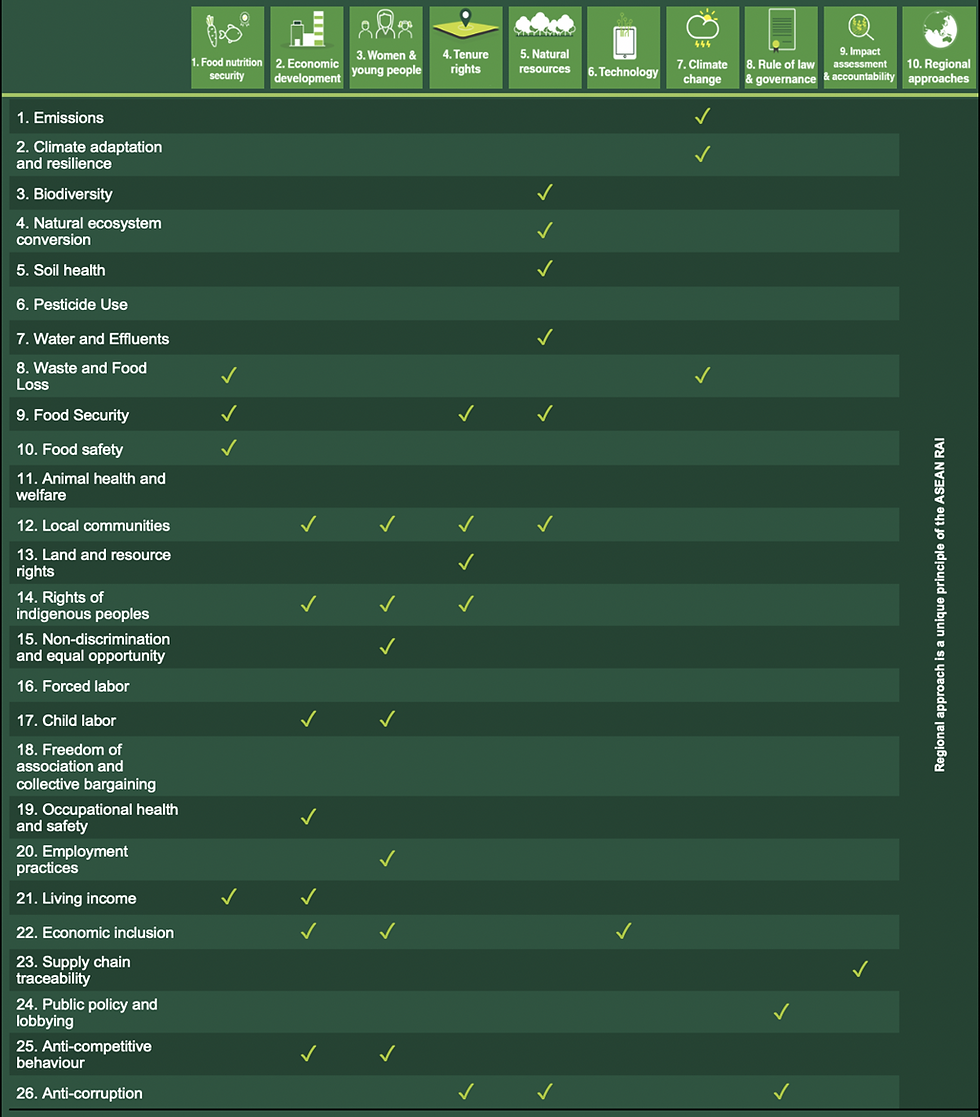Sustainability Reporting in the Agriculture, Aquaculture, and Fishing Sector and the ASEAN RAI
- Grow Asia Communications

- Aug 6, 2021
- 5 min read
Updated: Nov 21, 2022
On June 15, 2021, Grow Asia and the Global Reporting Initiative (GRI) together with Global Compact Network Singapore (GCNS) ran a dialogue to discuss the accuracy and feasibility of GRI’s proposed new Sector Standard on agriculture, aquaculture, and fishing in the Southeast Asian context, while building parallels with existing ASEAN-specific Guidelines like the ASEAN Responsible Investment in Food, Agriculture and Forestry ('ASEAN RAI').
The draft of the GRI Sector Standard for Agriculture, Aquaculture, and Fishing – which is currently under development – has twenty-six (26) material topics applicable for organizations undertaking crop production, animal production, aquaculture, and fishing. Margarita Lysenkova, Manager, GRI Standards, discussed these details in her presentation and also what is expected from organizations to report once the Sector Standard is finalized.
Erin Sweeney, Lead, Sustainable Investment & Inclusion at Grow Asia introduced the ASEAN RAI and how it aligns to the GRI’s draft sector standard. ASEAN RAI includes ten (10) environmental, social and governance (ESG) principles that specifically includes strengthening regional cooperation among ASEAN member countries. The ASEAN RAI was adopted by the 10 ASEAN Ministers of Agriculture and Forestry in 2018 and provides language for policymakers to use in updating and creating new agri-investment legislation. Through the regional adoption of the ASEAN RAI, it is now the de facto guide for food and forestry investment policy in the region. The ASEAN RAI also offers guidance to private investors who wish to align their practices in advance of policy change. Grow Asia and our partners are developing and piloting tools for public and private sector actors to better understand and adopt the 10 principles of the ASEAN RAI (learn more here).
The table below shows components where the ASEAN RAI Principles and the likely material topics of the GRI’s Sector Standard for Agriculture, Aquaculture, and Fishing (AAF) intersect.

For companies who are planning to adopt the GRI Sector Standard, the ASEAN RAI Principles on Economic Development, Women Youth, Indigenous People, and Natural Resource Conservation aligns well with material topics of the new AAF Sector Standard.
The alignment between the ASEAN RAI and GRI’s draft AAF Standard provides national and regional advantage for companies who will be using the new sector standard in their sustainability reporting. Those advantages include the business incentives in adopting the ASEAN RAI: to respond to upcoming policy change, unlock sustainable financing, become more competitive, communicate commitments, and learn from a network of organizations with similar ESG interests and goals.
Following the demo on the alignment between the ASEAN RAI and draft GRI AAF standard, deep-dive discussions were conducted to gather participants’ insights on major material topics: (1) farming and fishing practices; (2) impacts on use of land, resource rights and rights of communities; (3) environmental impacts; and (4) economic impacts and employment.
In the breakout sessions where major topics were discussed, participants identified three common themes, including recommendations for the draft GRI AAF Standard:
Companies reporting with the new AAF Standard will be able to refer to other sustainability standards. As an agricultural region, companies in Southeast Asia commonly export crops and other products outside the country of origin and the region, which means that these companies have adopted, to a certain degree, a “best practice” standard in their supply chain. Some agricultural standards mentioned were Good Agricultural Practices (GAP), which are localized by some ASEAN member countries, as well as organic agriculture certification. Participants emphasized that on topics of decent work the alignment should be sought with the standards under the International Labour Organization (ILO). Companies can now also reference the alignment of their investment practices to the ASEAN RAI, which covers regionally contextualized issue areas.
On GHG emissions, there are commodity-specific tools for carbon and water footprinting available that can be adopted in the new GRI AAF standard reporting. One example is for the banana sector currently tested by the World Banana Forum members. This tool could perhaps be adapted to other sectors and help quantify and report on climate and water impacts. The GRI AAF reporting can include positive and negative emissions including sequestration and practices that are used by companies and actors along their supply chains.
Partnership and engagement efforts should be included in the GRI sustainability report. The new AAF Standard intends to guide and encourage companies to build partnerships for reporting on its material topics. Companies should include in their reporting ways they are able to engage communities and other organizations. Partnership for the Sustainable Development Goals (SDG 17) is linked closely to the tenth principle of the ASEAN RAI on regional cooperation. ASEAN RAI Principle 10 talks about the value of building partnerships in the region among various organizations that should complement companies’ reporting on their environmental, economic, and social impacts. The creation and participation in such partnerships can be referenced in sustainability reporting.
Strategic partnerships can help provide insight, improve practices, and provide local capacity for companies in relation to various material topics, such as food security, biodiversity, land and resource rights (particularly for fisheries). For example, by partnering with local non-government organizations, companies will be able to have better insight and capacity to improve and address issues and challenges related to the aforementioned material topics.
Encourage disclosure of baseline analysis and environmental impact assessment results. Participants of the session recommended that companies should disclose results of assessments performed when evaluating their impacts, like baseline assessments and environmental impact assessment (EIA) among others, and this disclosure should be included in the new GRI AAF standard. In some ASEAN countries, the EIA is a requirement set by specific ministries and departments - commonly by the ministry or department of environment.
Participants indicated that the new AAF standard should also include specific guidelines on how companies should run climate risk scenarios and assessments, and include a list of acceptable tools and reference other standards. Climate risk assessments can help identify better climate adaptation practices and techniques, for example, on replanting crops for greater yield and/or improved biodiversity.
The global public comment period for GRI’s draft AAF Standard closed at the end of July. This feedback is now being considered and will inform the final version of the Sector Standard, which will launch in 2022. For any questions about the GRI AAF Standard, please get in touch with agriculture@globalreporting.org.
On ASEAN RAI, the principles are continuously updated based on issues and challenges that are specific to the region. More recently, our food system is being challenged by the pandemic and climate change as well. These threats can be mitigated by greater regional cooperation among policymakers and commitment to responsible environmental, social and governance practices among private investors. Companies and organizations may utilize the ASEAN RAI, along with other standards, to inform their sustainability journey. ASEAN RAI is closely aligned to majority of agriculture and food standards and certifications (both international guidance and sector-specific). To show how your existing commitments are compliant with the ASEAN RAI, check out this online tool (run by the International Trade Center) or our 2020 alignment report. To learn more and get involved in the ASEAN RAI, contact erin@growasia.org or visit www.aseanraiguidelines.org.



